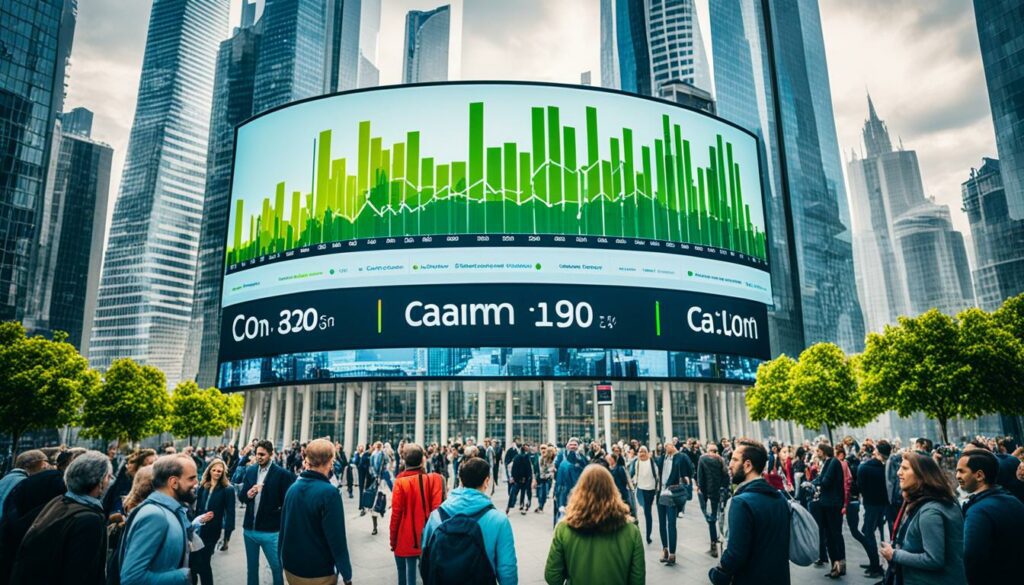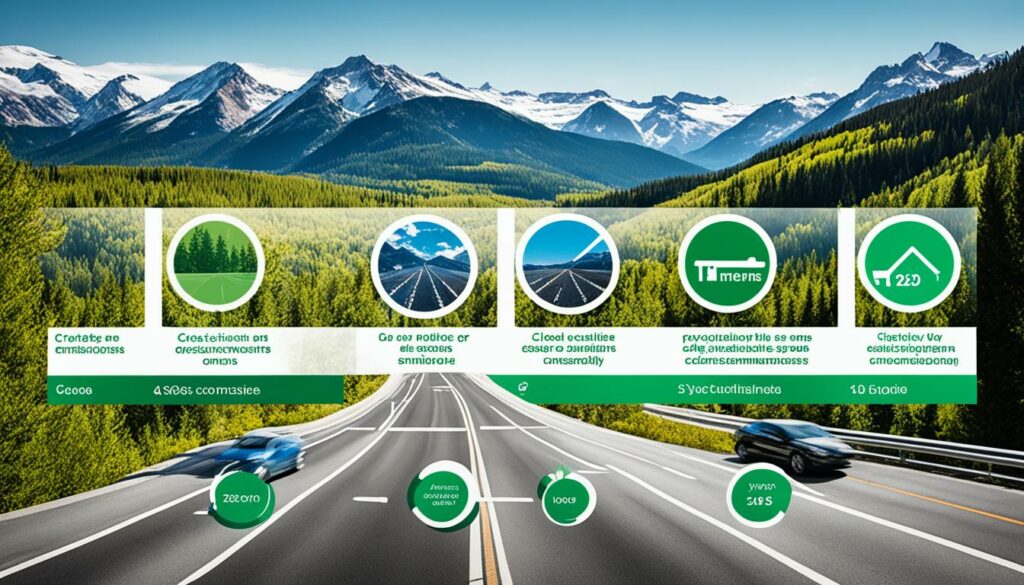Menu

The County of San Diego is making big moves with its Zero Carbon Portfolio Plan. This plan is all about electrifying its buildings. As we head into 2024, it’s clear that how we think about being green will change a lot. We’re focusing more on getting ready for the effects of climate change. This means looking after our environment better and saving money by avoiding health problems.
Big companies are going to be looking at how they can be more green. They’ll do this by checking out where their products come from. They’ll use better information and methods. AI will help them do this well. There’s also a lot of money moving into green projects. It shows how urgent it is that we find ways to do business without harming the planet.
New rules and goals will change how we all deal with the environment. The link between climate and our health is getting more attention, too. In 2024, we’ll see more focus and money on keeping people healthy by taking care of the planet.
In 2024, the world’s focus on measuring carbon footprints is growing. This highlights both risks and chances in how we tackle environmental issues. Stakeholders and policymakers will work hard to understand and reduce our carbon emissions forecast. Such action is due to many reasons, stressing the need to study greenhouse gas figures for better decisions.
The year 2023 saw global temperatures reach new heights. This pushes the need for better carbon footprint measurements. In 2024, new sustainability rules will be implemented globally. The EU has measures requiring companies to report on human rights and environmental impacts.
The UK also wants companies to reveal their emissions and energy use. These steps help get more data for greenhouse gas projections. They also guide new initiatives and policies towards environmental protection.
There are many reasons for the increased attention on carbon emissions. For one, the risks from climate change are more noticeable than ever, shown in 2023’s global temperatures. About a third of the largest European companies are now aiming to reduce deforestation and safeguard biodiversity. They see how these issues are closely linked to climate change.
Moreover, the health and financial effects of climate change are hard to ignore. The push for long-term investments in green practices is stronger now. Companies investing in sustainable futures tend to do better. Allegations of fake environmental claims and updated advertising rules ensure clearer messages. Thus, everyone must keep up with the new environment-related laws, whether they’re companies, investors, or policymakers.
| Drivers | Impact |
|---|---|
| Record global temperatures | Increased urgency in measuring carbon footprint |
| New sustainability regulations | Mandatory reporting on emissions and energy consumption |
| Biodiversity and climate intersection | Adoption of targets to protect biodiversity |
| Health implications from climate change | Economic and financial considerations |
| Misleading environmental claims | Higher standards in environmental communications |
The world’s climate hazards are getting worse. That’s why we need to focus more on adapting and being resilient. If we don’t, the world’s GDP could drop by up to 4.4% each year. This would be a huge hit for developing countries, so we must target our action there to help.

We must look at how climate changes are impacting our economies. For example, the U.S. faced $1 billion in losses from disasters in 2023. This shows the urgent need for projects that protect us, like building stronger buildings. Agencies tell us that for every dollar spent on making things safer, we save $6. In Broward County, $2 million spent before a hurricane saved $10 million in damages.
Every region faces climate change differently. Developing countries often suffer most and need special plans. The NCARS Act and the PREPARE Act aim to boost local and national ability to cope with disasters. They’re also helping by sharing money for better local plans. The financial world is now more aware of these needs too, which helps us get the funding we need.
| Region | Climate Hazard | Adaptation Investment | Expected Savings |
|---|---|---|---|
| U.S. | Weather & Climate Disasters | $1 billion | $6 billion |
| Broward County, FL | Hurricanes | $2 million | $10 million |
In the world of business, connecting governance with sustainability is key. It’s clear that we’re making new strategies better fit for sustainability. The year 2024 stands out because companies are striving for net zero. They’re also working hard to follow strict rules. Artificial intelligence is helping a lot with managing the environment.
By 2030, data use will multiply by eight. To use less physical space, companies are moving to online cloud services. This move to the cloud is powered by AI, making it easier to handle all the data. AI is playing a big role in improving how companies manage their impact on the environment.
AI helps businesses achieve their emission goals. It uses smart algorithms to choose the best ways to transport goods. This cuts down on harmful gases. AI also makes it easier to look at data in detail. This means companies can make better plans for a green future.
Getting reliable data for sustainability has never mattered more. In 2024, the EU will require over 50,000 businesses to be more open about their impact. This means companies need to keep very good track of their data. They should also be clear about how they measure their success in being greener.
This push for more info will help businesses work better with their suppliers. It will also ease worries for people who invest in or buy from these companies. Everyone wants to be sure that what companies tell us about their green efforts is true. At the same time, the business world is changing. More and more, company leaders are stepping up to work on big social and political issues. They’re making these part of how they run their business, too.
| Aspect | 2024 Prediction | Key Benefit |
|---|---|---|
| AI Integration | Increased adoption | Optimizes carbon emissions |
| Data Transparency | Mandatory disclosures | Enhanced stakeholder trust |
| Supply Chain Emissions | Collaborative reduction | Improved sustainability footprint |
The green, social, and sustainability bond market is growing fast. It’s on track to hit $1 trillion soon. Several reasons are pushing this growth.
Since they began, these bonds have reached $5.3 trillion. Just in the first three months of 2024, $333 billion flowed in. This shows more people want to invest in ways that help the planet and society. Green bonds are leading this charge, making up 63% of these investments.

Green bonds are big in both new and old markets. They make up 71% in new markets and 68% in old ones. But how much the government helps differs. It’s 23% in new places but 40% in old ones, showing different ways of supporting these bonds.
Many things are driving growth in the sustainability bond market. There’s a big push to cut carbon from our economy. The government playing its part, has issued 31% of all these bonds. Almost 60% of these are green bonds.
Companies in the utility business are playing a big role too. They’ve offered up $533 billion in bonds. Lately, they’ve upped this with an additional $33 billion. Countries are also very active. They’ve put out $437 billion in green bonds, which is like a third of what they sell overall.
Looking ahead, things will just keep growing, with more bonds being put out. Experts think by the end of 2024, $950 billion in sustainable bonds will be sold. Of this, green bonds will make up $580 billion. This includes all types like social bonds, sustainability bonds, and those linked to sustainability, showing a wide interest in this kind of financing.
| Region | Total Issuance (USD billion) | Market Proportion (%) |
|---|---|---|
| Global | 5,300 | 100 |
| Q1 2024 | 333 | 6.3 |
| Emerging Markets | 133 | 2.5 |
| Green Bonds (Public Sector) | 1,650 | 31 |
| Utilities | 533 | 10 |
The focus on social and sustainability bonds is also growing. It’s not just about the numbers. It’s about a deeper change in how we invest, focusing on helping the environment and people. In the future, we’ll see more investments made with our planet in mind.
The Corporate Sustainability Reporting Directive (CSRD) and Corporate Sustainability Due Diligence Directive (CSDDD) are new. They will change how companies report and comply with rules. Global companies will have to meet these high standards.
Starting with reports for 2025, all companies must talk about climate in their annual reports. If it’s a big company, it must tell how much CO2 it makes (Scope 1 or 2 emissions). It’s also a good idea to mention other emissions (Scope 3) that might affect the business.
Reporting on how extreme weather impacts the financials is now a must.
People in the financial market have a big say in making companies do these new things. They push for clearer reports on how sustainable a business is. Companies using the TCFD framework for climate reports are doing better. This shows how important good rules for reporting emissions are.
Now, it’s key for companies to give a lot of details on climate risks, rules, and how it all affects money. This is vital for keeping the financial market strong on sustainability.
Today, the challenges of losing biodiversity and changing climates are pushing companies to rethink how they deal with the environment. People everywhere are urging for plans that look at both biodiversity and climate. This means companies must come up with new ways that are good for nature and fair for everyone.

The new GRI 101: Biodiversity 2024 standard is changing how companies will talk about and handle their effect on nature. Biodiversity is very important, with over half the world’s economy tied to it. More than a billion people rely on forests, showing how essential nature is for our lives.
The standard focuses on the many living things that make up nature. It shows that people have greatly changed 70% of the land around the world. This means we need to really take care of nature, as many as a million species might disappear. Companies have to take strong steps towards protecting biodiversity.
Solving issues like losing biodiversity and climate change means finding solutions that are fair and good for the Earth. The Kunming-Montreal Agreement and UN’s Goals both want to stop nature loss while using resources wisely. They believe we must meet the needs of indigenous people as well.
Forests are very important, but we’ve lost a lot of wetlands. It’s key for companies to change the way they work. They must make sure their actions are good for everyone and don’t harm the environment.
| Impact Category | Statistics |
|---|---|
| Global GDP Dependence on Nature | Over 50% |
| Population Dependent on Forests | 1 Billion People |
| Threatened Species | Up to 1 Million |
| Disappearance of Wetlands | 85% |
| Alteration of Ice-Free Land by Humans | 70% |
| Reduction in Live Coral Reefs (last 150 years) | Nearly 50% |
The impacts of climate change on health risks are clearer now. In 2023, The Lancet Countdown report warned us over 50 pages. It calls for a big health push against climate change. At COP28 in 2024, leaders emphasised this by signing the “Health and Climate Change Declaration”. It shows they get how climate change leads to more health risks. These include more chances for sickness, less water and food, and extreme weather. We need to tackle these issues now.
Climate change hurts our health, and that costs us a lot of money. A 2023 look showed us the health bill might reach US$ 2–4 billion yearly by 2030. It’s not just about the health care money. It’s also about less work because it’s too hot, and businesses stopping due to diseases. America already felt this in its health care system in 2016. We have to make our health systems strong enough to handle this.
The COP28 meet marked a big step in facing climate-related health issues. Leaders from all over promised more than $1 billion to help fight these health dangers. These pledges at COP28 want to lower the bad health effects of climate change. They also aim to improve our health systems so they’re ready for future challenges, including the WHO’s goal to be carbon neutral by 2030.
In 2024, the Voluntary Carbon Market (VCM) is facing big changes. There’s a strong focus on the carbon credits being real and more rules to follow. This is making the market better.

Recently, people are looking more closely at if carbon credits are true. This need for real credits shows why strict rules are important. They predict $13 per ton in 2030 without high standards. But, with strong standards, prices could jump to $20 per ton. And they might go up to $146 per ton if focusing on removing carbon.
It shows how vital authentic carbon credits are. The Integrity Council for Voluntary Carbon Markets pushes for better and clear credits. This helps the market grow in a good way by selling sustainable market development.
The rules around carbon are getting stronger. Events like COP28 didn’t create a UN carbon market, but areas are making their own. California is upping its carbon price to $42 per metric ton in 2024. By 2030, it might hit $93 per ton.
In Europe, the price could drop to €71 per ton ($76 per ton) in 2024. But, it’s expected to rise to €149 per ton over time. This shows the growing effort to control and improve the VCM, making it useful for fighting climate change and helping companies cut emissions.
China aims to include more industries in its carbon market. This will help control more emissions. Places like Washington and California are working together. New York State also has plans to help markets grow. All these steps are important for the VCM’s success in the future.
The EU’s new directive on sustainability reporting has made things tougher for firms. It pushes companies to carefully check and control their social and environment effects. This means companies have to really dig deep into their operations to see where they impact sustainability the most.
The CSRD, starting in 2024, will force companies to up their reporting game. It’s making 81% of companies create new roles just to handle these rules. Aimed at making companies tell the truth about their green efforts, it also offers huge economic wins. Transitioning to a circular economy, for instance, is said to bring about USD 4.5 trillion in benefits by 2030. So, following these rules isn’t just about avoiding legal trouble; it’s about securing a better future for business.
Measuring the impact across a whole value chain is tough. Even though companies are trying, there’s still a lot of work to do on how to do this well. The way supplies move around makes this even trickier. With so much of the world’s money linked to nature, we must measure our impact correctly. The World Economic Forum sees ignoring this as one of our biggest risks for the next ten years.
It’s clear that we need new tech to help with these issues, as nearly every firm is planning to spend more on ESG tools. As we head towards 2024 and later, we all need to work together. This teamwork will help us get better at showing what we’re doing for the planet and our societies in a clear, honest way.
| Statistics | Details |
|---|---|
| Carbon-neutral goods and services market | $10.3 trillion by 2050 |
| Circular economy benefits | USD 4.5 trillion by 2030 |
| Dependency on nature | Over half of global GDP |
| New roles for disclosure requirements | 81% of companies |
| Investment in ESG tools | 99% of companies |
By the end of 2024, we might see a global agreement to reduce plastic pollution. This treaty could change how we use and throw away plastics. It aims to move us towards what’s called a ‘circular economy’.

Industries are preparing for this new way of working. They will focus on making products we can use again and recycle. It’s believed this change will need around $65 billion each year. With only under 10% of plastic getting recycled now, this is a big task.
Many places are already making laws to cut down on single-use plastics. For example, the EU is banning some of them by 2023. This shows a serious effort to deal with the plastic problem.
The damage from plastic pollution is both big for the planet and our wallets. Every year, plastic in the sea costs the world up to $2.5 trillion by harming nature. And it could cost $3.7 trillion to deal with the mess.
These high costs show that we must find better ways to manage plastic. Moving to a circular economy can help solve these big problems.
Many countries are already making big changes. Rwanda started by banning single-use bags and cutlery in 2008. This inspired 34 other African nations to do the same. In the United States, places like New York are also taking legal action against big plastic users. This holds them responsible for waste.
The global treaty on plastic pollution aims to change the way we see and use plastics. Instead of rubbish, they could become valuable again.
| Key Statistics | Data |
|---|---|
| Annual GDP loss due to climate hazards | Up to 4.4% |
| Marine plastic pollution ecosystem service reductions | 1% to 5% |
| Societal costs from plastic pollution in 2019 | US$3.7 trillion |
| Recycling rates for plastic | Below 10% |
| Projected oil demand growth driven by plastics | Nearly half by midcentury |
| Top 20 companies’ contribution to single-use plastics | Over 50% |
| Annual investment needed for circular economy | $65 billion |
Leveraging data is key in the journey to sustainability. It helps set goals and manage green practices. For example, moving a data centre reduced carbon by two tons each year.
Today, using data to be sustainable is crucial. It helps know what actions are most helpful. Groups like the Paris Agreement offer guidance, and technology plays a big role. For instance, using smart devices can track energy use in real-time.
Getting greener needs everyone at a company to work together. By looking at data from different parts of the business, they can find where to improve. This teamwork, both inside and outside companies, is vital for success.
Tracking carbon well is very important for big sites that make power or heat. Companies can handle their eco-data better with the right analytics. Working together across teams makes saving energy and cutting carbon possible.
| Metric | Data |
|---|---|
| Membership in the Automatic Controls and Robotics Division | 4.5K members |
| Library resources available | 36 |
| Number of blogs in the community | 3 |
| Number of events hosted | 0 |
Businesses aim to reach net zero by 2030. They need to address emissions from Scope 1, 2, and 3 sources. While tackling Scope 2 emissions has shown improvement, Scope 1 and 3 are trickier. They require new and team-based solutions.

Scope 3 emissions come from the supply chain and are hard to deal with. It’s crucial to measure and cut them down. The UK’s carbon footprint is heavily linked to the built area, making this even more vital. Working with tech companies and choosing honest carbon offset plans is key. Also, keeping an eye on energy market trends helps with price risks. This way, companies can choose low carbon tech more easily.
Switching to EV fleets helps reduce Scope 1 emissions a lot. This change needs a good plan, like setting up charging stations. Using new tech in managing emissions is also a plus. For example, vibration sensors help with fixing things before they break. And CO2 detectors can adjust how buildings use energy right when it’s needed. These new solutions not only cut emissions but also push towards the net zero goal.
Smart buildings are key for saving energy and protecting the environment. They use AI for energy efficiency and the IoT in sustainable development. This makes building management much better.
Smart buildings can cut energy use by 70% thanks to IoT sensors and AI analytics. While the start-up cost is higher, long-term saving is big. They help the planet by using renewable energy like geothermal systems and advanced storage.
Smart buildings work better with advanced data systems. They use AI and IoT to check how much energy to use, based on how many people are there. This smart way cuts waste and helps the environment. It also predicts when things might break, saving time and money on fixes.
But, smart buildings do face challenges. They need a lot of money at the start and collect a lot of data, which some people worry about. Still, more and more places are building them thanks to government help and good rules. New ideas like buildings that make their own energy show the future is bright for these green buildings.
As AI and IoT grow, so will the smart building market. Research from Frost & Sullivan shows big changes coming, from better management to improved safety. For companies and builders, using these new ideas is key to staying ahead and helping the planet.
As we get closer to 2024, the path to sustainable growth faces its own set of problems and chances. The shipping world, dealing with more than 80% of global trading, is key to this change. Yet, it adds about 3% of the world’s greenhouse gas emissions and meets reroutes due to global issues, upping delays. This increases the push for swift action on climate change.
The European Union now counts maritime emissions in their trading system. This move shows rules will be essential in changing how we handle our carbon footprint. A carbon tax might up shipping costs by 3-5%, which could be put onto buyers. Air freight could offer a solution for expensive products, but issues between countries cause longer, less efficient paths, upping emissions.
Working together is vital for making supply chains stronger, especially in fields like semiconductors, batteries, and electric cars. The fact that one country may control vital battery elements, and that 37 minerals are critical, according to the US Defence Department, shows how weak our chains are. So, nations need to unite to ensure sustainability and keep economies strong.
Bringing in the best tech and advice from experienced people like Tony Giustini and John Wilkins is key. This helps us make better policies and business moves. By working together on these fronts, we’re on a good track to hit big green goals and make our future friendlier to the planet.
In 2024, it’s crucial to measure carbon footprint more than ever. This is due to people realising the risks of climate change. Measuring it helps find areas to improve and meet stricter rules. It also shows customers and investors what steps we’re taking.
More attention on carbon emissions comes from three key factors. They are the rising dangers of climate change, rules that ask us to disclose more, and the costs it has on health. The link between losing nature and climate change is another big reason why we watch and reduce carbon releases.
The economy-hit from climate shocks has a big effect. Without ways to adapt, it could cost the world up to 4.4% of its GDP. To shield against this, both businesses and governments are coming up with plans that are specific to each area. This is to reduce the money dangers from climate issues.
The need to adapt to climate change differs by region. Places that are still developing might face harder hits. They need strategies focusing on their local needs. This includes making sure their cities, health, and money are ready for climate changes.
Artificial intelligence (AI) does a lot to make our ways greener. It offers smart ways to use data, manage risks, and save resources. By using AI, businesses can plan better for a greener future. They can predict, check harmful gas releases, and even report all more easily.
Top-notch data and being clear matter a lot for green efforts. They help in giving the true picture of how we’re doing. This builds trust with our partners and makes sure we’re following the rules right. It also helps in making smarter choices for the planet.
In 2024, the green bond market is set to soar near
In 2024, it’s crucial to measure carbon footprint more than ever. This is due to people realising the risks of climate change. Measuring it helps find areas to improve and meet stricter rules. It also shows customers and investors what steps we’re taking.
More attention on carbon emissions comes from three key factors. They are the rising dangers of climate change, rules that ask us to disclose more, and the costs it has on health. The link between losing nature and climate change is another big reason why we watch and reduce carbon releases.
The economy-hit from climate shocks has a big effect. Without ways to adapt, it could cost the world up to 4.4% of its GDP. To shield against this, both businesses and governments are coming up with plans that are specific to each area. This is to reduce the money dangers from climate issues.
The need to adapt to climate change differs by region. Places that are still developing might face harder hits. They need strategies focusing on their local needs. This includes making sure their cities, health, and money are ready for climate changes.
Artificial intelligence (AI) does a lot to make our ways greener. It offers smart ways to use data, manage risks, and save resources. By using AI, businesses can plan better for a greener future. They can predict, check harmful gas releases, and even report all more easily.
Top-notch data and being clear matter a lot for green efforts. They help in giving the true picture of how we’re doing. This builds trust with our partners and makes sure we’re following the rules right. It also helps in making smarter choices for the planet.
In 2024, the green bond market is set to soar near $1 trillion. It’s because more of these bonds are needed while other global markets slow down. This big jump shows a worldwide push to cut down CO2 and more money-going into green deals.
There’s a big desire for planet-friendly investments pushing the market to grow. Also, there’s a stronger call to cut emissions and new big plans, like the EU’s, that aim for more green info. This all means that, now more than ever, how we treat the earth matters a lot in our money choices.
The new rules and demands, like from the EU, ask companies worldwide to really look into and show how they’re doing green. It’s a big change that makes companies work harder to collect and show their green steps more clearly. This makes sure companies all over are really trying to be better for the planet.
The actions of financial market players really make sure companies tell the truth about their green efforts. They want better and more open talks on green impacts. Their checks and help make sure companies are fair in what they say. This helps in making smarter money moves for the world.
Big companies are now putting more thought into how they can be fairer to nature and people. They look at how these two big problems are linked and try to solve them together. This is because now, more than before, customers and groups ask for actions that are good for nature and people.
At COP28, leaders agreed to really work on fixing climate problems for better health. They put in $1 billion to fight health risks from climate changes. This shows that the world needs strong health plans that really get the earth’s challenges.
The trustworthiness of carbon credits in the Voluntary Market is up to how well emission cuts are shown. Groups like the Integrity Council are key in making sure credits are real. This helps in being sure that our efforts to cut carbon really do help the planet.
Meeting the EU’s demand to report fully on green work is tough for companies. They need better skills, plans, and ways to show their green steps properly. Getting these things in line lets them report on all their green efforts well.
Worldwide bans on plastic and a focus on recycling and reusing mean businesses have to change how they make and throw away things. They have to support plastic-free ways and come up with new products. This is a big step in battling overusing plastic and asks for large efforts in making and using things in better ways.
Data is key in hitting our green goals. It helps with checking the rules, how we’re doing, and making smart decisions. Good and full data lets companies set better green goals, keep a check on how they’re going, and work together well for a greener world.
Scope 3 emissions matter a lot in reaching zero carbon goals. They make up the biggest part of a company’s carbon footprint. Tackling these unseen emissions needs us to all work together word to really meet our climate targets.
Firms are getting creative in lessening their direct emissions. They refresh their fleets, use smart tech, and plan better for green growth. These steps are vital in ending their direct carbon harm and moving towards a zero carbon future.
Smart places are helping a lot in saving energy and being kinder to the earth. They use the latest in AI and tech to manage energy, do tasks before they go bad, and adjust to what we really need. Their smart systems help in using up energy right, cut down on bad gases, and up overall green performance.
There’s a big desire for planet-friendly investments pushing the market to grow. Also, there’s a stronger call to cut emissions and new big plans, like the EU’s, that aim for more green info. This all means that, now more than ever, how we treat the earth matters a lot in our money choices.
The new rules and demands, like from the EU, ask companies worldwide to really look into and show how they’re doing green. It’s a big change that makes companies work harder to collect and show their green steps more clearly. This makes sure companies all over are really trying to be better for the planet.
The actions of financial market players really make sure companies tell the truth about their green efforts. They want better and more open talks on green impacts. Their checks and help make sure companies are fair in what they say. This helps in making smarter money moves for the world.
Big companies are now putting more thought into how they can be fairer to nature and people. They look at how these two big problems are linked and try to solve them together. This is because now, more than before, customers and groups ask for actions that are good for nature and people.
At COP28, leaders agreed to really work on fixing climate problems for better health. They put in
In 2024, it’s crucial to measure carbon footprint more than ever. This is due to people realising the risks of climate change. Measuring it helps find areas to improve and meet stricter rules. It also shows customers and investors what steps we’re taking.
More attention on carbon emissions comes from three key factors. They are the rising dangers of climate change, rules that ask us to disclose more, and the costs it has on health. The link between losing nature and climate change is another big reason why we watch and reduce carbon releases.
The economy-hit from climate shocks has a big effect. Without ways to adapt, it could cost the world up to 4.4% of its GDP. To shield against this, both businesses and governments are coming up with plans that are specific to each area. This is to reduce the money dangers from climate issues.
The need to adapt to climate change differs by region. Places that are still developing might face harder hits. They need strategies focusing on their local needs. This includes making sure their cities, health, and money are ready for climate changes.
Artificial intelligence (AI) does a lot to make our ways greener. It offers smart ways to use data, manage risks, and save resources. By using AI, businesses can plan better for a greener future. They can predict, check harmful gas releases, and even report all more easily.
Top-notch data and being clear matter a lot for green efforts. They help in giving the true picture of how we’re doing. This builds trust with our partners and makes sure we’re following the rules right. It also helps in making smarter choices for the planet.
In 2024, the green bond market is set to soar near $1 trillion. It’s because more of these bonds are needed while other global markets slow down. This big jump shows a worldwide push to cut down CO2 and more money-going into green deals.
There’s a big desire for planet-friendly investments pushing the market to grow. Also, there’s a stronger call to cut emissions and new big plans, like the EU’s, that aim for more green info. This all means that, now more than ever, how we treat the earth matters a lot in our money choices.
The new rules and demands, like from the EU, ask companies worldwide to really look into and show how they’re doing green. It’s a big change that makes companies work harder to collect and show their green steps more clearly. This makes sure companies all over are really trying to be better for the planet.
The actions of financial market players really make sure companies tell the truth about their green efforts. They want better and more open talks on green impacts. Their checks and help make sure companies are fair in what they say. This helps in making smarter money moves for the world.
Big companies are now putting more thought into how they can be fairer to nature and people. They look at how these two big problems are linked and try to solve them together. This is because now, more than before, customers and groups ask for actions that are good for nature and people.
At COP28, leaders agreed to really work on fixing climate problems for better health. They put in $1 billion to fight health risks from climate changes. This shows that the world needs strong health plans that really get the earth’s challenges.
The trustworthiness of carbon credits in the Voluntary Market is up to how well emission cuts are shown. Groups like the Integrity Council are key in making sure credits are real. This helps in being sure that our efforts to cut carbon really do help the planet.
Meeting the EU’s demand to report fully on green work is tough for companies. They need better skills, plans, and ways to show their green steps properly. Getting these things in line lets them report on all their green efforts well.
Worldwide bans on plastic and a focus on recycling and reusing mean businesses have to change how they make and throw away things. They have to support plastic-free ways and come up with new products. This is a big step in battling overusing plastic and asks for large efforts in making and using things in better ways.
Data is key in hitting our green goals. It helps with checking the rules, how we’re doing, and making smart decisions. Good and full data lets companies set better green goals, keep a check on how they’re going, and work together well for a greener world.
Scope 3 emissions matter a lot in reaching zero carbon goals. They make up the biggest part of a company’s carbon footprint. Tackling these unseen emissions needs us to all work together word to really meet our climate targets.
Firms are getting creative in lessening their direct emissions. They refresh their fleets, use smart tech, and plan better for green growth. These steps are vital in ending their direct carbon harm and moving towards a zero carbon future.
Smart places are helping a lot in saving energy and being kinder to the earth. They use the latest in AI and tech to manage energy, do tasks before they go bad, and adjust to what we really need. Their smart systems help in using up energy right, cut down on bad gases, and up overall green performance.
The trustworthiness of carbon credits in the Voluntary Market is up to how well emission cuts are shown. Groups like the Integrity Council are key in making sure credits are real. This helps in being sure that our efforts to cut carbon really do help the planet.
Meeting the EU’s demand to report fully on green work is tough for companies. They need better skills, plans, and ways to show their green steps properly. Getting these things in line lets them report on all their green efforts well.
Worldwide bans on plastic and a focus on recycling and reusing mean businesses have to change how they make and throw away things. They have to support plastic-free ways and come up with new products. This is a big step in battling overusing plastic and asks for large efforts in making and using things in better ways.
Data is key in hitting our green goals. It helps with checking the rules, how we’re doing, and making smart decisions. Good and full data lets companies set better green goals, keep a check on how they’re going, and work together well for a greener world.
Scope 3 emissions matter a lot in reaching zero carbon goals. They make up the biggest part of a company’s carbon footprint. Tackling these unseen emissions needs us to all work together word to really meet our climate targets.
Firms are getting creative in lessening their direct emissions. They refresh their fleets, use smart tech, and plan better for green growth. These steps are vital in ending their direct carbon harm and moving towards a zero carbon future.
Smart places are helping a lot in saving energy and being kinder to the earth. They use the latest in AI and tech to manage energy, do tasks before they go bad, and adjust to what we really need. Their smart systems help in using up energy right, cut down on bad gases, and up overall green performance.